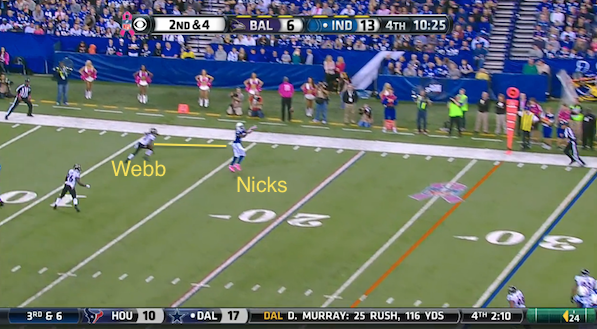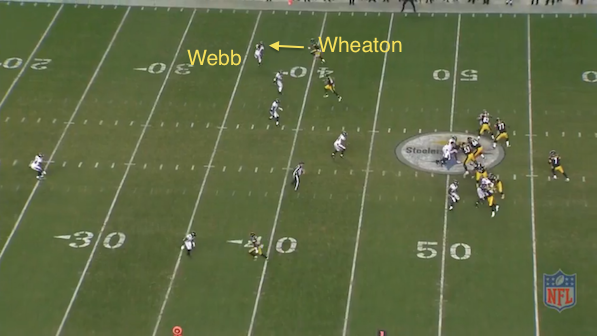Despite the 6-4 start by the Baltimore Ravens and by all accounts a rather successful season thus far, much has been made about the middling state of the team’s secondary.
Without star cornerback Jimmy Smith, the team essentially has no standout players in coverage, with most cornerbacks and safeties getting noticed for slip-ups instead of notable positive plays.
That includes veteran cornerback Lardarius Webb, whose recent career decline hasn’t done the Ravens defense any favors. Once widely viewed as one of the NFL’s young budding stars at cornerbacks, a 2012 ACL injury derailed Webb’s career upswing, and nothing has been the same.
After missing much of the 2012 season, Webb returned to action in 2013, looking satisfactory in terms of speed and athleticism. But still, at Webb’s peak in 2011, he was one of the most athletic cornerbacks in the game.
Now? Webb’s athleticism is often weak enough to the point that it is an inherent liability.
Having just turned 29 and dealing with various injuries to his knee and back in recent seasons, it’s time to finally start accepting the new Lardarius Webb, one which is a far cry from the dominant defender who had 20 passes defended and five interceptions in 2011.
To understand the decline in Webb’s play, let’s go back to the time in which he was often the most athletic defender on the field for the Ravens.
In 2011, Webb had a breakout season which was full of outstanding plays in coverage.
During a Thanksgiving duel with the San Francisco 49ers, Webb’s innate one-on-one coverage ability was on display.
Webb quickly diagnoses the go route by the receiver down the sideline and turns his hips in plenty of time to follow the receiver toward the end zone.
Webb’s timely play gives him ample time to position himself in front of the intended target, Braylon Edwards (how’s that for a throwback name?).
He turns his back to Edwards and shifts his body so that he can locate the ball in the air while also shielding the intended target from making a play.
Webb is able to locate the ball in the air while maintaining his positioning in front of Edwards for the duration of the play.
The end result is an interception by Webb in the end zone to end the half.
Webb’s ability to turn his hips and run with Edwards ultimately allowed him to make the play.
Later in the season, during the AFC Championship Game, Webb’s elite athleticism was noticeable.
Guarding New England Patriots receiver Julian Edelman in the slot, Webb is slightly thrown off by the receiver’s short area quickness and agility, allowing Edelman to create separation downfield.
However, even though Webb gives up some space to Edelman, it’s not enough to prevent Webb from still making a play on the ball.
What could have been a considerable gain for the Patriots offense turned into a change of possession after Webb stretched out for the interception.
Nowadays? Separation such as this likely leads to a completion when throwing in Webb’s direction. Back during his prime, completions didn’t come easily against the talented cornerback.
Fast forward to 2014 and it’s easy to notice the unfortunate decline in Webb’s play.
One game this season which was painful to watch was Baltimore’s Sunday night loss to the Pittsburgh Steelers. The speed of the Steelers receivers gave Webb trouble all night.
Matched up on the outside against speedster Markus Wheaton, Webb follows the route and has ample space to react on what is ultimately a streak down the sideline by Wheaton.
About 15 yards downfield, Webb still holds his ground and runs stride for stride with Wheaton.
However, Steelers quarterback Ben Roethlisberger knows what most others know as well: Webb simply isn’t as fast as he used to be.
The quarterback readies to throw before Wheaton even gains separation, knowing that Webb won’t have the speed to keep up for the duration of the play.
As expected, Wheaton separates himself from Webb, and with the ball still in the air, the receiver slides past the defender.
The end result is a 47-yard touchdown for Pittsburgh.
Deep speed has given Webb some trouble this season, but even the short passing game, one of Webb’s past strength’s has led to issues.
Going back to an early October matchup with the Indianapolis Colts, Webb’s inability to effortlessly change direction and close in on a quick pass was noticeable.
Squaring off against Hakeem Nicks on the outside, Webb turns his hips much too early in the play and shifts his entire weight away from the receiver.
This would be fine if Nicks were running a streak, but the exact opposite is the case.
Nicks breaks his route toward the sideline.
Webb’s back is turned to Nicks when the receiver cuts back toward the quarterbacks.
Approximately four yards separate the two players as Nicks hauls in the reception with Webb helplessly attempting to recover in time.
Both Webb’s decision to turns his hips so early in the play and his inability to change direction quickly enough ultimately doom him.
While still an NFL-caliber cornerback who isn’t completely defunct of his once dominant skill set, it’s about time to start accepting the new, less consistent Webb.
At age 29, Webb is nearing the end of his prime (if he hasn’t already reached that point) in terms of athletic ability, and nagging injuries don’t help his cause.
Under contract through 2017 with hefty sums of money headed his way, Webb likely won’t live up to his contracts for the remainder of his time in Baltimore, however long that may be.
With a depleted set of cornerbacks on the team, it will be up to the veteran Webb to step up and lead the secondary in order to aid Baltimore’s run at the playoffs.


















